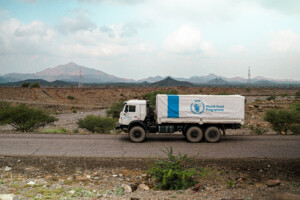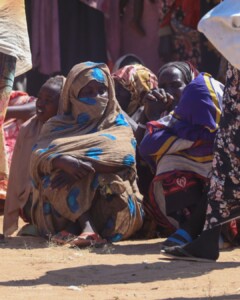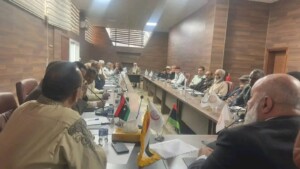Sudan OCHA bulletin 30: Aid for flood-affected displaced in South Darfur
Aid organisations respond to the damages caused by heavy rain and flooding in displaced people’s camps in South Darfur, Sudan. On 23 July, an inter-agency mission comprising UN agencies, international NGOs and local government authorities visited Kalma camp in Bielel locality, to assess such damages that occurred on 16 July. The mission found that 780 homes were damaged and all corresponding household belongings, including food stocks and seeds, had washed away. The floods also damaged 756 household latrines, 511 of which were washed away.
The latest news bulletin by the United Nations’ Office for the Coordination of Humanitarian Affairs (OCHA) reported that the American Refugee Committee is now rehabilitating and disinfecting the damaged household latrines. The international NGO Care International – Switzerland (CIS) has secured funding to replace the 511 washed-out latrines. However, the latrines will not be replaced until the displaced people living in flood-prone areas of the camp relocate to more suitable locations. The UNHCR plans to provide emergency household supplies once the verified beneficiary list is received from the International Organization for Migration (IOM).
Newly displaced in Mellit
An estimated 3,350 people have been displaced by tribal fighting that erupted in the first week of July in North Darfur’s Mellit locality. OCHA reports that they have received food, plastic sheets, and blankets from the government’s Humanitarian Aid Commission (HAC). The African Union-United Nations Mission in Darfur (Unamid) has twice trucked water to Mellit town, but this supply has run out, forcing the displaced people to fetch water from nearby sources and a borehole made by Unamid. Meanwhile Unicef and the Ministry of Health, as well as the German Red Cross began mid-upper arm circumference screening for children under five years, and began treating cases of severe and moderate acute malnutrition.
On 3 August, the IOM will send a team to verify the number of displaced people in Mellit town. Once verification is completed, the World Food Programme (WFP) will provide a one-month emergency food ration and UNHCR will provide a full package of emergency household supplies to all affected families.
Gaps in Abu Karinka response
Families in Abu Karinka and El Gidamia towns in East Darfur affected by fighting between militant Rizeigat and Ma’aliya tribesmen mid-May have been provided with food, nutrition, and water and sanitation assistance, in addition to emergency household supplies by aid organisations. After access to these areas was denied for one month by the Sudanese government, a rapid assessment team was allowed to enter on 11 June. The assessment took place unhindered.
Food aid to Central Darfur delayed
Since late June 2015, WFP has been attempting to transport 90 metric tons of food to Central Darfur’s Guldo town for some 9,500 people who have been displaced in the area since March 2015. It awaits authorisation to travel to the area. A total of 16,200 displaced people fled to Guldo town from Rokoro locality in the northern Jebel Mara area, as a result of conflict between government forces and armed groups this year.
More South Sudanese refugees than expected
As of 22 July, the total number of new South Sudanese refugees who arrived in Sudan has reached 198,657, exceeding the response planning figure of 196,000 people. According to the UN Refugee Agency (UNHCR), in the past week alone Sudan received a total of 4,814 refugees from South Sudan at an average rate of 688 people per day. White Nile State received the majority of new refugees (1,331).
With such a high rate of arrivals within a short period of time, aid organisations have not had sufficient time to scale-up services and facilities in camps. Refugees from South Sudan started arriving in Sudan in mid-December 2013 following the eruption of conflict in the country.
Cholera
Although no cases of cholera or outbreaks of diarrheal diseases have been reported in Sudan this year, measures to respond to acute water diarrhoea and cholera oubreaks are underway throughout the country. With the onset of the rainy season and the continued influx of refugees from South Sudan, where the number of cholera cases continues to rise, humanitarian organisations are concerned about the diseases. Subsequently, the joint contingency plan prepared by the Ministry of Health plans to include the states of South Darfur, Gedaref, Kassala, Sinnar, Gezira, Northern and River Nile, in addition to the initial seven priority states of Khartoum, White Nile, Blue Nile, South Kordofan, West Kordofan, East Darfur and Central Darfur. The federal Ministry of Finance supports the plan with SDG1 million (US$186,000) contribution to implement phase one of the contingency plan targeting the seven priority states.
Aid organisations respond to the damages caused by heavy rain and flooding in displaced people's camps in South Darfur, Sudan. An estimated 3,350 people have been displaced by tribal fighting that erupted in the first week of July in North Darfur's Mellit locality and have received food assistance. The total number of new South Sudanese refugees who arrived in Sudan has reached 198,657, exceeding the response planning figure of 196,000 people.
On 23 July, an inter-agency mission comprising UN agencies, international NGOs and local government authorities visited Kalma camp in Bielel locality, to assess such damages that occurred on 16 July. The mission found that 780 homes were damaged and all corresponding household belongings, including food stocks and seeds, had washed away. The floods also damaged 756 household latrines, 511 of which were washed away.
The latest news bulletin by the United Nations' Office for the Coordination of Humanitarian Affairs (OCHA) reported that the American Refugee Committee is now rehabilitating and disinfecting the damaged household latrines. The international NGO Care International – Switzerland (CIS) has secured funding to replace the 511 washed-out latrines. However, the latrines will not be replaced until the displaced people living in flood-prone areas of the camp relocate to more suitable locations. The UNHCR plans to provide emergency household supplies once the verified beneficiary list is received from the International Organization for Migration (IOM).
Newly displaced in Mellit
An estimated 3,350 people have been displaced by tribal fighting that erupted in the first week of July in North Darfur's Mellit locality. OCHA reports that they have received food, plastic sheets, and blankets from the government's Humanitarian Aid Commission (HAC). The African Union-United Nations Mission in Darfur (Unamid) has twice trucked water to Mellit town, but this supply has run out, forcing the displaced people to fetch water from nearby sources and a borehole made by Unamid. Meanwhile Unicef and the Ministry of Health, as well as the German Red Cross began mid-upper arm circumference screening for children under five years, and began treating cases of severe and moderate acute malnutrition.
On 3 August, the IOM will send a team to verify the number of displaced people in Mellit town. Once verification is completed, the World Food Programme (WFP) will provide a one-month emergency food ration and UNHCR will provide a full package of emergency household supplies to all affected families.
Gaps in Abu Karinka response
Families in Abu Karinka and El Gidamia towns in East Darfur affected by fighting between militant Rizeigat and Ma’aliya tribesmen mid-May have been provided with food, nutrition, and water and sanitation assistance, in addition to emergency household supplies by aid organisations. After access to these areas was denied for one month by the Sudanese government, a rapid assessment team was allowed to enter on 11 June. The assessment took place unhindered.
Food aid to Central Darfur delayed
Since late June 2015, WFP has been attempting to transport 90 metric tons of food to Central Darfur’s Guldo town for some 9,500 people who have been displaced in the area since March 2015. It awaits authorisation to travel to the area. A total of 16,200 displaced people fled to Guldo town from Rokoro locality in the northern Jebel Mara area, as a result of conflict between government forces and armed groups this year.
More South Sudanese refugees than expected
The total number of new South Sudanese refugees who arrived in Sudan has reached 198,657, exceeding the response planning figure of 196,000 people, as of 22 July. According to the UN Refugee Agency (UNHCR), in the past week alone Sudan received a total of 4,814 refugees from South Sudan at an average rate of 688 people per day. White Nile State received the majority of new refugees (1,331).
With such a high rate of arrivals within a short period of time, aid organisations have not had sufficient time to scale-up services and facilities in camps. Refugees from South Sudan started arriving in Sudan in mid-December 2013 following the eruption of conflict in the country.
Cholera
Although no cases of cholera or outbreaks of diarrheal diseases have been reported in Sudan this year, measures to respond to acute water diarrhoea and cholera oubreaks are underway throughout the country. With the onset of the rainy season and the continued influx of refugees from South Sudan, where the number of cholera cases continues to rise, humanitarian organisations are concerned about the diseases. Subsequently, the joint contingency plan prepared by the Ministry of Health plans to include the states of South Darfur, Gedaref, Kassala, Sinnar, Gezira, Northern and River Nile, in addition to the initial seven priority states of Khartoum, White Nile, Blue Nile, South Kordofan, West Kordofan, East Darfur and Central Darfur. The federal Ministry of Finance supports the plan with SDG1 million (US$186,000) contribution to implement phase one of the contingency plan targeting the seven priority states.
Read the full weekly bulletin here











 and then
and then